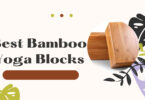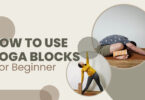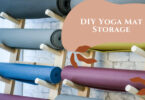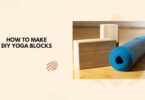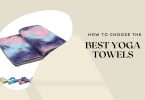Yoga blocks are tools that help yogis of all levels find balance and support in their practice. But what makes a yoga block truly useful? It is the MATERIAL that it’s made of. The material affects its weight, durability, and comfort grip. Finding the best material for yoga blocks involves considering how easy it is to carry, its ability to provide stability during poses, and how well it holds up over time. Additionally, a material that feels comfortable against the skin and has a non-slip surface can significantly enhance the yoga experience. Let’s explore the materials that are commonly used for yoga blocks and discover which best fits your practice.
What Are Yoga Blocks?
Yoga blocks are simple tools that are used in yogasanas to provide support, stability, and assistance in alignment. They are rectangular and constructed using different materials such as foam, cork, or wood. Yoga blocks come in various sizes which allow the practitioners to modify their poses and accommodate their individual needs and abilities. For instance, these can be used as an extension of the arms to support various human body parts such as the back, hips, and head.
What Are the Types of Materials for Yoga Blocks?
The most widely used materials for yoga blocks include the following:
1. Cork
Cork yoga blocks are made using the bark of cork oak trees. They are natural, renewable, and 100% biodegradable. Cork blocks have a firm yet slightly porous texture that provides a comfortable grip and stability.
Cork blocks are suitable for experienced practitioners or those who are seeking for strong support and balance. They are especially beneficial for standing poses, balance exercises, and difficult poses that demand a solid base.
Pros:
- Non-toxic
- Sweatproof
- Provides excellent traction and grip
- Durable and resistant to bacteria, odor, and moisture
Cons:
- Heavier than some other materials; some practitioners may find them less comfortable than softer options

2. Foam
Foam yoga blocks are constructed with high-density foam (EVA foam) which provides a lightweight and cushioned feel. They have a soft and comfortable texture, moderate grip, and support.
Foam blocks are versatile and well-suited for practitioners of all levels. They are often used by beginners for gentle stretches, restorative poses, and support for various poses where a softer surface is preferred.
Pros:
- Lightweight and easy to carry, most suitable for beginners
- Provides a gentle surface for those who prefer a softer feel
- Depending on their construction, certain yoga blocks may exhibit a stiffness that are similar to cork blocks.
Cons:
- May compress over time and provide less stability than denser materials
- Some are non-biodegradeable

3. Wood
Wood yoga blocks are made from sustainable and sturdy hardwood such as bamboo, balsa, birch, pine, maple, and poplar. They have a natural and aesthetically pleasing appearance with smooth and solid surface.
Wood blocks are favored by practitioners who prioritize stability and solid base. They are well-suited for standing poses, inversions, and advanced poses that require strong support.
Pros:
- Offers excellent stability and durability
- Has a firm and solid feel
- Easiest to clean
Cons:
- Bulkier than other materials; its hardness may feel less comfortable for certain individuals.

Which of the three materials that we mentioned is the best for you? Here’s how to decide.
Which Yoga Block Material Is the Best?
The best yoga block material for you depends on your requirements and personal preference. The following are the few characteristics that may help you make up your mind.
1. Density and Weight
The density and weight of the yoga block impact its portability and stability. These blocks provide a solid foundation which reduces the chances of wobbling or shifting.
To elaborate, the lightweight blocks are perfect for on-the-go individuals, as they are easy to carry and do not add much weight. Medium-density blocks offer stability and support without feeling too heavy. Heavyweight blocks provide added stability and minimize movement in advanced poses.
Best material: Cork
2. Durability and Longevity
The best durable yoga block should resist the wear-and-tear while maintaining its shape and structural integrity over time. It should withstand the repeated use and pressure even with continuous use.
When picking a yoga block material that lasts long, avoid the ones that are prone to cracking or breaking as they can compromise functionality and your safety in performing yogasanas.
Best material: Cork
3. Comfort and Grip
A non-slip surface ensures a secure grip and steadiness during practice which allows for proper alignment. Try the different types of yoga block material to check their level of softness and cushioning for comfortable use. The latter enhances comfort during seated or reclined poses where the block supports your body.
However, be careful and avoid materials that may cause skin irritation, especially if you have sensitivities. Consider opting for hypoallergenic materials or using a cover on the block to protect your skin and ensure a comfortable and irritation-free yoga practice.
Best Material: Foam
4. Eco-Friendliness and Sustainability
It is recommended to consider the environmentally conscious materials in yoga blocks. Those made from sustainably sourced natural fibers or recycled materials support sustainable practices and reduce environmental impact. Biodegradable or recyclable options minimize the waste and contribute to a smaller ecological footprint.
So, understand the production process of the blocks first and then choose a yoga block. This may involve selecting blocks that are manufactured using less energy-intensive processes or those that are produced with renewable energy sources.
Best material: Cork
5. Cleanliness
As yoga blocks come into contact with the body and the floor, selecting a material that is easy-to-clean and maintain is essential. Some materials like cork and foam are naturally resistant to moisture and bacteria which make them easier to wipe down and to keep hygienic.
It is suggested to avoid materials that may absorb sweat or develop unpleasant odors over time. Opt for a yoga block material that promotes cleanliness where you can ensure a more pleasant and sanitary yoga session.
Best material: Foam
Conclusion
Selecting the right material for your yoga block is crucial for a fulfilling and safe yoga regime. Whether you prioritize portability, stability, or sustainability, there is a material that aligns with your preferences perfectly. Choosing a yoga block material that suits your needs and values can enhance your practice, helps you find better support, and contribute to a more sustainable yoga journey.


